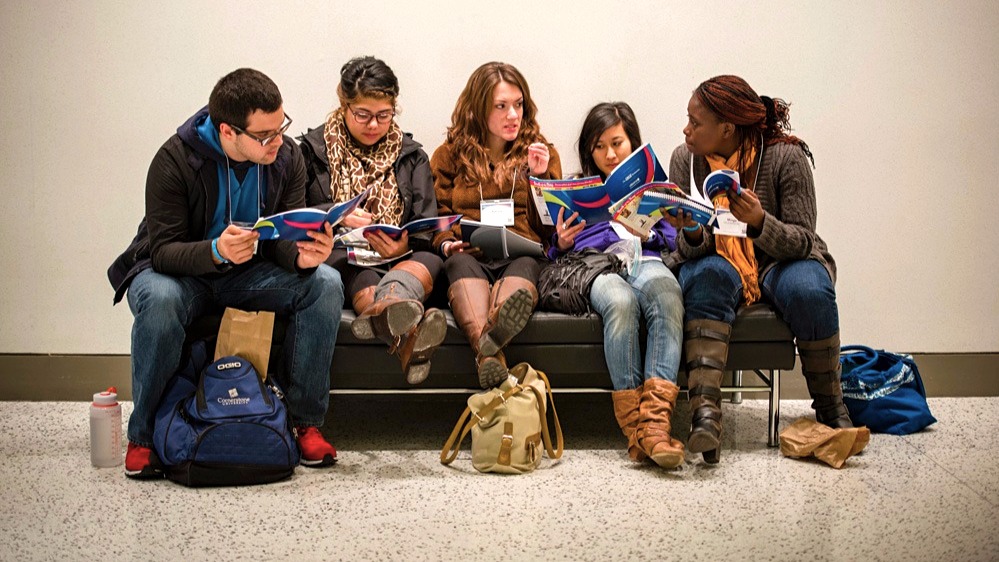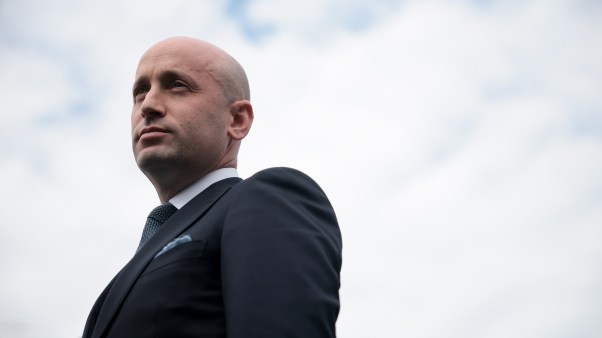A massive compilation of surveyed Americans across all 50 states offers a rare look at minority Christians.
While Protestants in the United States remain mostly white, the share of Protestants of color has grown steadily from 17 percent in 1991 to 33 percent in 2016, according to a report released today by Public Religion Research Institute (PRRI).
“The American religious landscape has undergone dramatic changes in the last decade, and is more diverse today than at any time since modern sociological measurements began,” reported PRRI on its 2016 American Values Atlas, based on more than 101,000 bilingual surveys between January 2016 and January 2017.
In fact, the number of nonwhite Protestants has grown so large that the group has surpassed white mainline Protestants, and has nearly caught up with white evangelical Protestants.
Added together, minority Protestants—including black Protestants (8%), Hispanic Protestants (4%), and “Asian, mixed-race, or other” Protestants (3%)—make up 15 percent of the US population, while white mainliners make up 13 percent and white evangelicals make up 17 percent. (The margin of error makes this essentially a three-way tie.)
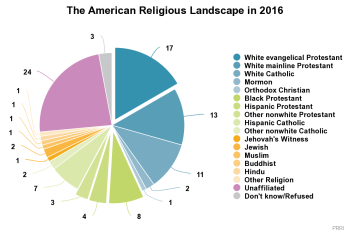
While white evangelicals, which PRRI defines as people who self-identify as both Protestant Christians and as evangelical or born again—have dropped from 23 percent of Americans in 2006, PRRI noted that they remain the “single largest religious tradition.” (By comparison, the Pew Research Center found that 25.4 percent of Americans were evangelical in 2014, down only slightly from 26.3 percent in 2007.)
To split it another way: Among white Americans, 68 percent are Christians, 47 percent are Protestants, and 27 percent are evangelicals. Among African Americans, 75 percent are Christians, 67 percent are Protestants, and 42 percent are evangelicals. Among Asian Americans, 30 percent are Christians and 16 percent are Protestants.
Among Hispanic Americans, 73 percent are Christians, but only 25 percent are Protestants. About half of those Protestants are evangelicals, according to PRRI. (LifeWay Research found a similar result this summer: 60 percent of Hispanic Protestants surveyed identified as evangelicals.)
Or to split it yet another way: About a quarter of Americans (26%) are self-identified evangelicals. About two-thirds of those evangelicals are white (64%), while 19 percent are black, 10 percent are Hispanic, and the remaining 6 percent are Asian, mixed race, or other ethnicities.
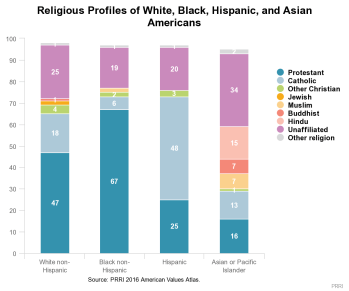
But that doesn’t mean that each US denomination is about a third nonwhite. “The degree of racial and ethnic diversity among Protestants varies considerably between denominational families,” PRRI noted.
Some of America’s largest denominational families are the most diverse.
Baptists are far and away the biggest, making up close to a third of the nation’s Protestants (32%). In fact, Baptists are so numerous that they’re three times the size of the next closest denominational families—Methodist (10.1%), Pentecostals (9.7%), and Lutherans (7.7%).
Baptists are also pretty diverse: 58 percent are white, 30 percent are black, and 5 percent are Hispanic.
Pentecostals are even more diverse: 50 percent are white, 25 percent are Hispanic, and 17 percent are black.
But more people doesn’t always equal more diversity. More than 8 in 10 Methodists are white (83%), as are more than 9 in 10 Lutherans (92%). The much-smaller Presbyterians (83%) and Episcopalians (80%) are also predominately white.
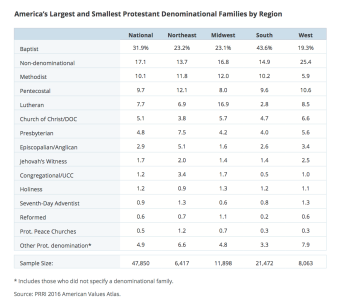
Nondenominational Protestant churches, which contain 17 percent of the US population, are 67 percent white, 13 percent black, and 10 percent Hispanic.
And it looks like this diversity will only increase over time.
“Like all Christians in the US, evangelical Protestants are experiencing a substantial racial and ethnic transformation,” PRRI reported. “Young evangelical Protestants are far more racially and ethnically diverse than previous generations.”
Half of evangelicals under 30 years old are now nonwhite (50%), a far higher share than among evangelicals older than 65 (23%). PRRI found that “22 percent of young evangelical Protestants are black, 18 percent are Hispanic, and 9 percent identify as some other race or mixed race.”
This generational split can also be found in the political sphere.
Only half of white evangelicals now identify as Republicans (49%), followed by independents (31%) and Democrats (14%).
The growing number of independents are defecting Democrats, according to PRRI. While the percentage of Republicans who identify as white evangelicals has remained steady since 2006 (37% then, 35% now), the percentage of Democrats who identify as white evangelicals has shrunk from 17 percent in 2006 to 8 percent in 2016.
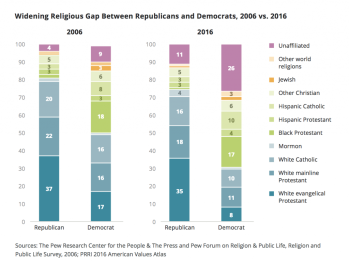
The Democrats who remain are older. White evangelicals over 65 are almost twice as likely as those under 30 to identify as Democrats (18% vs. 10%), while both age groups lean heavily Republican (49% vs. 47%).
“Nonwhite Christians tend to lean more toward the Democratic Party, although there is significant diversity in the partisan preferences of these groups,” PRRI reported. “No religious group more strongly identifies with the Democratic Party than black Protestants.”
Indeed, while more than two-thirds of black Protestants identify as Democrats (68%), less than 4 percent identify as Republicans. However, black Protestants also have a generation gap. Seniors are much more likely (79%) than the under-30 crowd (58%) to identify as Democrats.
Hispanic Protestants are more evenly split: 4 out of 10 identify as independents (41%), while 3 out of 10 identify as Democrats (30%) and less than 2 out of 10 identify as Republicans (17%).
Most white evangelicals identify as politically conservative (62% vs. 15% liberal). More evenly split are black Protestants (30% conservative, 29% liberal) and Hispanic Protestants (33% conservative, 29% liberal).
Among the extensive report’s other findings:
- Women are still more likely to be evangelicals than men. More than half of white evangelicals (56%), black Protestants (58%), and Hispanic Protestants (53%) are female.
- Four out of 10 LGBT Americans identify as Christians, including 6 percent as white evangelicals, 8 percent as white mainline, 6 percent as black Protestants, and 3 percent as Hispanic Protestants. A plurality (46%) are religiously unaffiliated.
- More than half of evangelicals have been to college (52%), though only a quarter have graduated with a degree (25%). Fewer black Protestants (48%) and Hispanic Protestants (35%) have been to college.
- More than 2 out of 5 black Protestants (43%) and Hispanic Protestants (45%) live in households earning less than $30,000 a year. Meanwhile, white evangelicals, like other white Christian groups, are doing better economically. Just 28 percent of white evangelical households make less than $30,000 a year.
- Home ownership also splits along racial lines. Three quarters of white evangelicals (75%) own their homes, compared with 46 percent of black Protestants and 38 percent of Hispanic Protestants.
- White evangelicals are more likely to have health insurance through their employer (43%) than black (35%) or Hispanic (31%) Protestants. But they aren’t less likely to have government-sponsored health care (30% white evangelicals vs. 30% black Protestants vs. 21% Hispanic Protestants). Meanwhile, 3 in 10 Hispanic Protestants (29%) have no health coverage at all.
- White evangelicals (64%) are more likely than black (37%) or Hispanic (45%) Protestants to be married, but less likely (27%) than black (33%) or Hispanic (48%) Protestants to have children under the age of 18 living at home.

